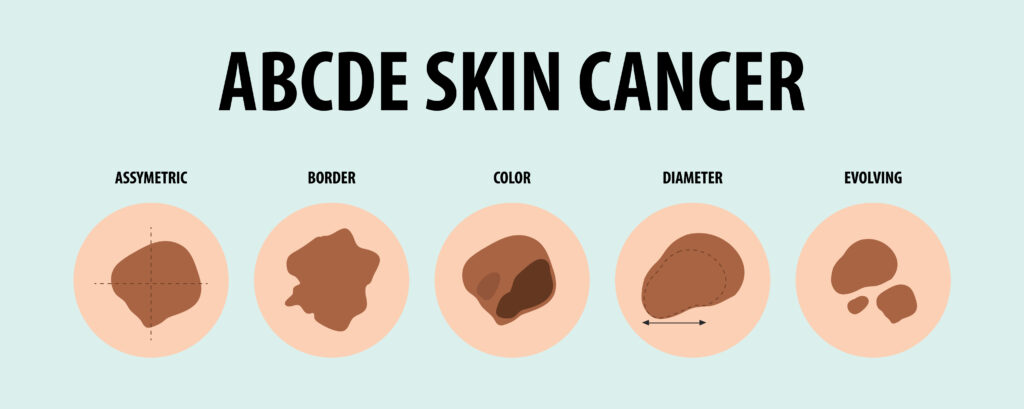Skin Cancer Facts
- 1 in 5 Americans will have skin cancer in their life (this number is higher for those who spend a lot of time in the sun.)
- It is estimated that 7,990 deaths from melanoma will occur in the United States in 2023.
- Skin cancer is a largely preventable cancer. The two most common skin cancers (basal cell and squamous cell carcinomas) are highly curable but can be disfiguring and costly.
- Melanoma (the third most common skin cancer) may be deadly. Melanoma is more common as you age, but can occur in those younger than 30.
- Most people spend at least some time outdoors. Our DIG group is passionate about encouraging healthy skin practices and increasing awareness about the exposure of UV Radiation. Making sun protection a part of your everyday routine will help you avoid sunburns, lower your skin cancer risk, and have fun in the sun in the safest way!
Risk Factors
UV Radiation from the sun or from a tanning device is one of the main risk factors for getting skin cancer. Other risk factors include:
-
- Light skin, or skin that burns, freckles, or reddens easily (but skin of all colors can get skin cancer)
- Certain types and a large number of moles
- Personal or family history of skin cancer
- Excessive sun exposure
- History of sunburns, especially in early life
- Older age
- Indoor tanning (we need to have our own fun facts here)
- The average tanning bed gives off 2 to 10x more UV radiation than the sun
- Using tanning beds before the age of 35 increases risk for developing melanoma by 75%
Skin Cancer in People of Color: includes people of African, Asian, Latino, Mediterranean, Middle Eastern, and Native American descent:
Even if you have a darker skin tone, always tan or rarely burn, everyone is still at risk for skin cancer. Skin cancer is often diagnosed later in people of color, making it harder to treat. It doesn’t matter whether you consider your skin light, dark, or somewhere in between. You are at risk for skin cancer. Being in the sun can damage your skin. Sunlight causes damage through ultraviolet, or UV rays, (they make up just one part of sunlight). Two parts of UV, UVA and UVB, can both cause damage to skin. Also, the sun isn’t the only cause of skin cancer. There are other causes. That’s why skin cancer may be found in places on the body never exposed to the sun. More specifically, melanoma in people of color most often occurs on the palms of the hands, soles of the feet, under the nail (subungual) and in the nail areas. No matter your skin tone, UV radiation can lead to skin damage, premature aging, and hyperpigmentation. Protecting your skin is important!
How Can We Prevent Skin Cancer?
- Wear sunscreen When Possible!
- Wear sunscreen that states its broad spectrum and is at least SPF 30+, if possible. reapply frequently, aim for every two hours). If you’re concerned about not receiving enough Vitamin D, talk to your provider about receiving supplements!
- Gear Up And Wear Protective Clothing!
-
- Wear a hat (neck and face are frequent areas of sun damage). Try to find hats that cover the neck and face.
- Wear long sleeves and long pants.
- Wear sunglasses to protect your eyes and the skin around your eyes as these are sensitive areas for sun damage.
- Stay Out Of The Sun!
- You can reduce your risk of sun damage and skin cancer by staying in the shade, under an umbrella, tree, or other shelter. Your best bet to protect your skin is to use sunscreen or wear protective clothing when you’re outside—even when you’re in the shade.
- Whenever possible, avoid sun exposure from 10 am-4pm.
- Check the UV Index,
- Dermatologists recommend the above sun safety measures when the UV index is 3 and above. As levels approach 6 and above, it’s best to limit your time in the sun.
- Ask Your Provider!
- If you are concerned about a spot, don’t hesitate to ask a physician to look at it. They may take a sample of your skin to check for cancer cells. They can also let you know more about your risk of skin cancer.
What Signs Can We Look Out For To Identify Skin Cancer?
A: Asymmetry: Melanomas are frequently asymmetrical: the shape of one half does not match the other.
B: Borders: Melanomas frequently have uneven or irregular borders (ragged or notched edges).
C: Color: Melanomas often contain multiple shades of brown or black but can sometimes be mixed with white, gray, blue, or red. Some melanomas will show a loss of color in a preexisting mole or in the area surrounding the mole.
D: Diameter: Melanomas are often larger than 6 mm (1/4 inch) in diameter. However, with increased awareness about early detection, about 30% of melanomas are found when they are less than 6 mm in diameter.
E: Evolving: Any change: Melanomas typically have shown some evidence of change in the months prior to diagnosis.
How Do We Check For Spots?
Resources
American Academy of Dermatology
Skin Clinics Nearby (Arlington Skin Clinic Occasionally Provides Free Skin Screenings)
Skin Cancer Risk Factors (CDC) https://www.cdc.gov/skin-cancer/risk-factors/index.html
How to Do a Self Skin Exam (https://www.cancer.org/cancer/risk-prevention/sun-and-uv/skin-exams.html)
Melanoma Risk Assessment Tool (https://mrisktool.cancer.gov/)
National Cancer Institute — Who Can Get Skin Cancer? (https://www.cancer.gov/types/skin/anyone-can-get-skin-cancer)
Skin Cancer in People of Color (https://www.skincancer.org/skin-cancer-information/skin-cancer-skin-of-color/
JPS Hospital
RAM (Remote Area Medical) Typically in November or December
Skin Cancer Foundation:
Skin Cancer Facts & Statistics
Facts about skin cancer in people of color
American Academy of Dermatology:
Skin Cancer Prevention
The Dangers of Indoor tanning
Indoor tanning stats and facts
Skin Cancer stats and facts



Social media